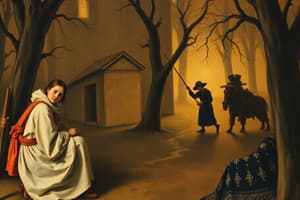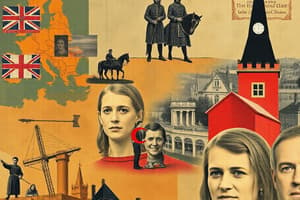Podcast
Questions and Answers
The Middle Ages began with the fall of the Eastern Roman Empire and transitioned into the Renaissance.
The Middle Ages began with the fall of the Eastern Roman Empire and transitioned into the Renaissance.
False (B)
The Carolingian Renaissance, known for its fervent revival of classical learning and arts, occurred during the reign of Charlemagne.
The Carolingian Renaissance, known for its fervent revival of classical learning and arts, occurred during the reign of Charlemagne.
True (A)
The two-field system of crop rotation significantly decreased agricultural output during the High Middle Ages.
The two-field system of crop rotation significantly decreased agricultural output during the High Middle Ages.
False (B)
The Crusades were primarily motivated by economic opportunities rather than religious zeal.
The Crusades were primarily motivated by economic opportunities rather than religious zeal.
The Magna Carta, signed in 1215, expanded the power of the English monarch.
The Magna Carta, signed in 1215, expanded the power of the English monarch.
The Black Death primarily impacted rural populations, leaving urban centers relatively untouched.
The Black Death primarily impacted rural populations, leaving urban centers relatively untouched.
The Hundred Years' War primarily involved naval conflicts between Spain and Portugal.
The Hundred Years' War primarily involved naval conflicts between Spain and Portugal.
During the Middle Ages, the clergy had very little influence on political matters.
During the Middle Ages, the clergy had very little influence on political matters.
Gothic cathedrals are characterized by rounded arches and massive walls.
Gothic cathedrals are characterized by rounded arches and massive walls.
The Battle of Hastings in 1066 resulted in the Norman conquest of England.
The Battle of Hastings in 1066 resulted in the Norman conquest of England.
Flashcards
The Middle Ages
The Middle Ages
Period spanning from 5th to 15th century, from the fall of the Western Roman Empire to the Renaissance.
Early Middle Ages
Early Middle Ages
Early period (c. 5th-10th centuries) with declining urban centers and the rise of Germanic kingdoms.
High Middle Ages
High Middle Ages
Period (c. 1000-1300) of population growth, agricultural innovation, and the Crusades.
Late Middle Ages
Late Middle Ages
Signup and view all the flashcards
Feudalism
Feudalism
Signup and view all the flashcards
Manorialism
Manorialism
Signup and view all the flashcards
Christianity (Middle Ages)
Christianity (Middle Ages)
Signup and view all the flashcards
Romanesque Architecture
Romanesque Architecture
Signup and view all the flashcards
Gothic Architecture
Gothic Architecture
Signup and view all the flashcards
The Black Death
The Black Death
Signup and view all the flashcards
Study Notes
- The Middle Ages, aka the medieval period, existed from the 5th to the 15th century
- It started with the fall of the Western Roman Empire and merged into the Renaissance and the Age of Discovery
- Traditionally divided into three periods: Early, High, and Late Middle Ages
Early Middle Ages (c. 5th – 10th centuries)
- Characterized by the decline of urban centers, population displacement, and invasions
- The collapse of Roman infrastructure led to a decrease in trade, learning, and overall living standards
- The rise of Germanic kingdoms occurred, including the Franks, Visigoths, and Ostrogoths; each established their own territories and legal systems
- The Frankish kingdom, led by Clovis I, became a dominant power, leading to the rise of the Carolingian dynasty
- The Carolingian Renaissance occurred during Charlemagne's reign, marked by revived interest in classical learning/arts
- Monasticism flourished; ancient texts were preserved and social services provided, with monasteries becoming centers of learning and stability
- Christianity spread via missionaries, converting pagan populations and solidifying the Church's influence
- Viking raids began in the late 8th century, impacting coastal areas of Europe and leading to settlements and trade routes
High Middle Ages (c. 1000 – 1300)
- Witnessed significant population growth, agricultural innovation, and the revival of urban life
- Farming techniques such as the three-field system and the heavy plow increased agricultural output
- Feudalism became the dominant social/political system, structuring society around reciprocal relationships between lords and vassals
- The Crusades were religious wars sanctioned by the Latin Church, aiming to recapture the Holy Land from Muslim control
- Growth of trade networks and merchant guilds facilitated economic expansion and the rise of a merchant class
- Magnificent Gothic cathedrals reflected the wealth and religious fervor
- Universities were founded, promoting the study of theology, law, medicine, and the arts, contributing to intellectual development
- The Magna Carta was signed in 1215, limiting the English monarch's power and establishing principles of law/governance
Late Middle Ages (c. 1300 – 1500)
- Marked by crises such as the Great Famine, the Black Death, and the Hundred Years' War
- The Black Death, a plague, killed a significant portion of Europe's population, causing social and economic upheaval
- The Hundred Years' War between England and France resulted in political instability and significant military developments
- Feudalism declined due to changing economic conditions and the rise of centralized states
- The Renaissance began in Italy, marked by a renewed interest in classical art, literature, and philosophy, signaling a transition to the modern era
- Johannes Gutenberg's printing press revolutionized communication and facilitated the spread of knowledge
- Exploration and maritime advancements paved the way for the Age of Discovery, leading to European expansion and colonization
Social Structure
- Society was structured into a hierarchical system (feudalism), with the King at the top, followed by nobles, knights, and peasants
- The clergy formed a distinct social class, wielding significant religious and political influence
- Peasants formed the majority, working the land and providing labor to their lords
- The emergence of a merchant class in urban centers challenged the traditional feudal order
- Social mobility was limited, but opportunities for advancement existed through the Church or through success in trade
Economic Systems
- The medieval economy was primarily agrarian, with most people engaged in farming
- Manorialism organized agricultural production, with peasants working land owned by lords in exchange for protection
- Trade flourished along established routes, connecting regions and facilitating the exchange of goods
- Guilds regulated crafts/trades in urban centers, ensuring quality and protecting the interests of their members
- The rise of banking and finance supported economic growth, with institutions providing loans and facilitating transactions
Religion and Culture
- Christianity was the dominant religion, shaping moral values, artistic expression, and intellectual thought
- The Church played a central role in education, providing training for clergy and maintaining schools
- Religious art and architecture, including illuminated manuscripts and Gothic cathedrals, reflected spiritual beliefs
- Pilgrimages to holy sites were common, fostering religious devotion and cultural exchange
- Popular religious movements, such as monasticism and mendicant orders, emphasized piety and service to the poor
- Superstition and folklore were prevalent, with beliefs in magic, witchcraft, and supernatural beings influencing everyday life
Art and Architecture
- Romanesque architecture was characterized by rounded arches, massive walls, and ornate decorations
- Gothic architecture featured pointed arches, ribbed vaults, and stained glass windows, creating soaring spaces filled with light
- Illuminated manuscripts were intricately decorated books, often containing religious texts and artistic illustrations
- Sculpture adorned cathedrals and public spaces, depicting biblical scenes, saints, and allegorical figures
- Tapestries and textiles served as decorative and functional elements, adorning walls and furnishing homes
Key Events
- The Battle of Hastings in 1066 marked the Norman conquest of England, transforming English society and governance
- The Investiture Controversy was a conflict between the papacy and European monarchs over the appointment of church officials
- The Magna Carta signing in 1215 limited the king's power and established principles of law/governance
- The Black Death in the mid-14th century decimated Europe's population, leading to social and economic upheaval
- The Fall of Constantinople in 1453 marked the end of the Byzantine Empire and signaled the decline of the Middle Ages
Decline of the Middle Ages
- The rise of centralized states challenged the feudal order, with monarchs consolidating power and establishing bureaucracies
- Economic changes, such as trade growth and the rise of a merchant class, transformed society and weakened feudal ties
- Intellectual/cultural developments, including the Renaissance and the Reformation, challenged traditional beliefs and values
- The Age of Discovery led to European expansion/colonization, shifting global power and trade
- Political, economic, and cultural shifts led to the gradual decline of the Middle Ages and the transition to the modern era
Studying That Suits You
Use AI to generate personalized quizzes and flashcards to suit your learning preferences.




